Product and Service Development: Processes, Lifecycle, Dove & Teamwork
VerifiedAdded on 2023/06/09
|11
|3077
|448
Report
AI Summary
This report comprehensively analyzes product and service development processes, focusing on customer integration and product lifecycle management. It details the stages of product development, from idea generation to commercialization, and applies these processes to a specific organizational product, using Dove and its potential foot care line as a case study. The report also assesses the lifecycle stages of products in a company’s portfolio, evaluates product line management choices, and includes a reflective statement on team working, creative development, and presentation. The analysis covers various aspects of Dove's product lines, including washing and bathing, skin care, antiperspirants and deodorants, and hair care, emphasizing the importance of aligning new products with existing product line properties. Desklib provides this and other solved assignments for students.
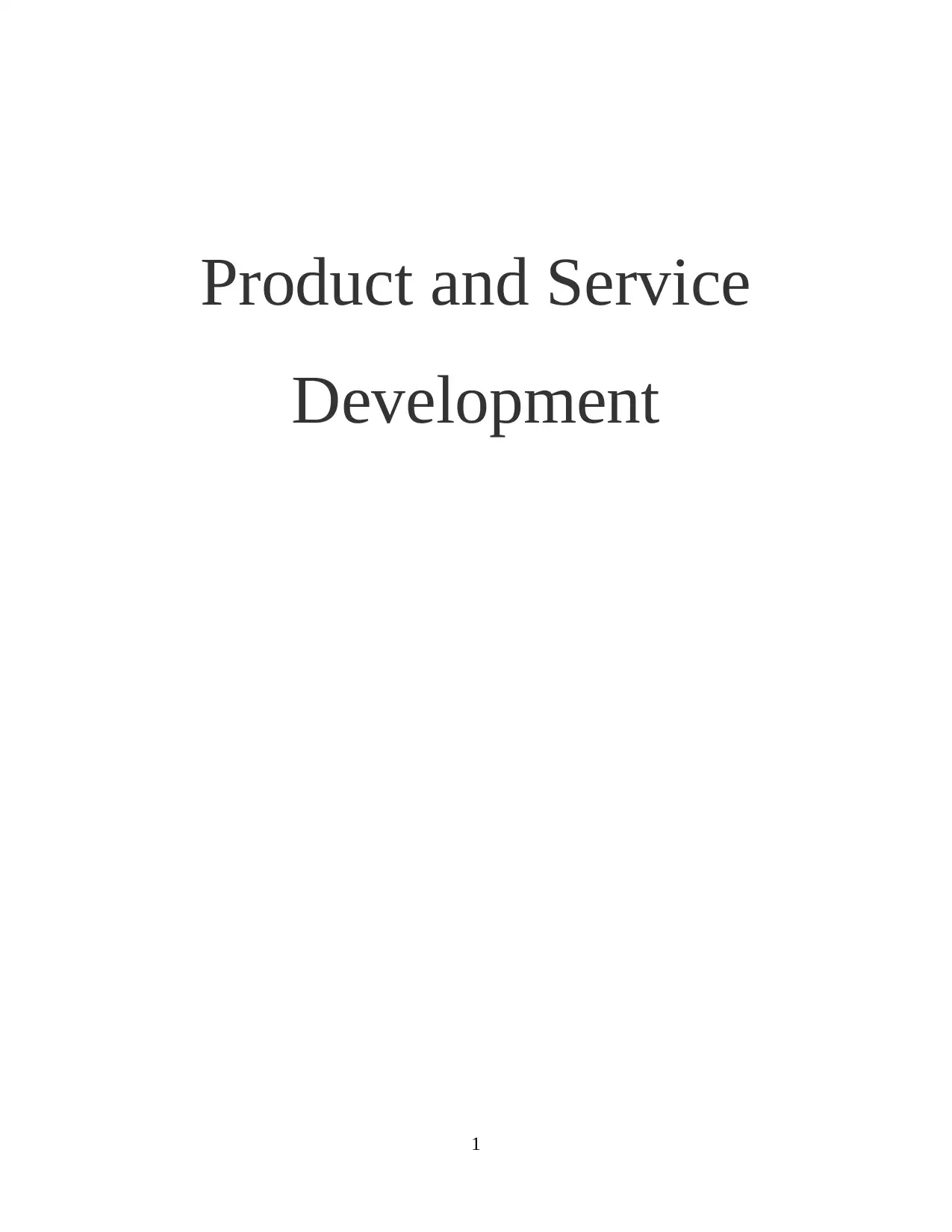
Product and Service
Development
1
Development
1
Paraphrase This Document
Need a fresh take? Get an instant paraphrase of this document with our AI Paraphraser

Contents
Contents...........................................................................................................................................2
INTRODUCTION...........................................................................................................................3
Main Body.......................................................................................................................................3
Task 1...............................................................................................................................................3
Explain the processes involved in the development of products and services and the levels of
customer integration....................................................................................................................3
Apply these processes in application to the development of a specific organisational product or
service..........................................................................................................................................5
Task 2...............................................................................................................................................6
Assess the life-cycle stage of the products or services in a company’s portfolio........................6
Evaluate which appropriate product line management choices are required for individual
products or services.....................................................................................................................7
Task 3 (PPT)....................................................................................................................................8
Task 4...............................................................................................................................................8
Complete a reflective statement that critically reflects on team working, creative development
and presentation...........................................................................................................................8
Conclusion.......................................................................................................................................9
REFERENCES..............................................................................................................................10
2
Contents...........................................................................................................................................2
INTRODUCTION...........................................................................................................................3
Main Body.......................................................................................................................................3
Task 1...............................................................................................................................................3
Explain the processes involved in the development of products and services and the levels of
customer integration....................................................................................................................3
Apply these processes in application to the development of a specific organisational product or
service..........................................................................................................................................5
Task 2...............................................................................................................................................6
Assess the life-cycle stage of the products or services in a company’s portfolio........................6
Evaluate which appropriate product line management choices are required for individual
products or services.....................................................................................................................7
Task 3 (PPT)....................................................................................................................................8
Task 4...............................................................................................................................................8
Complete a reflective statement that critically reflects on team working, creative development
and presentation...........................................................................................................................8
Conclusion.......................................................................................................................................9
REFERENCES..............................................................................................................................10
2
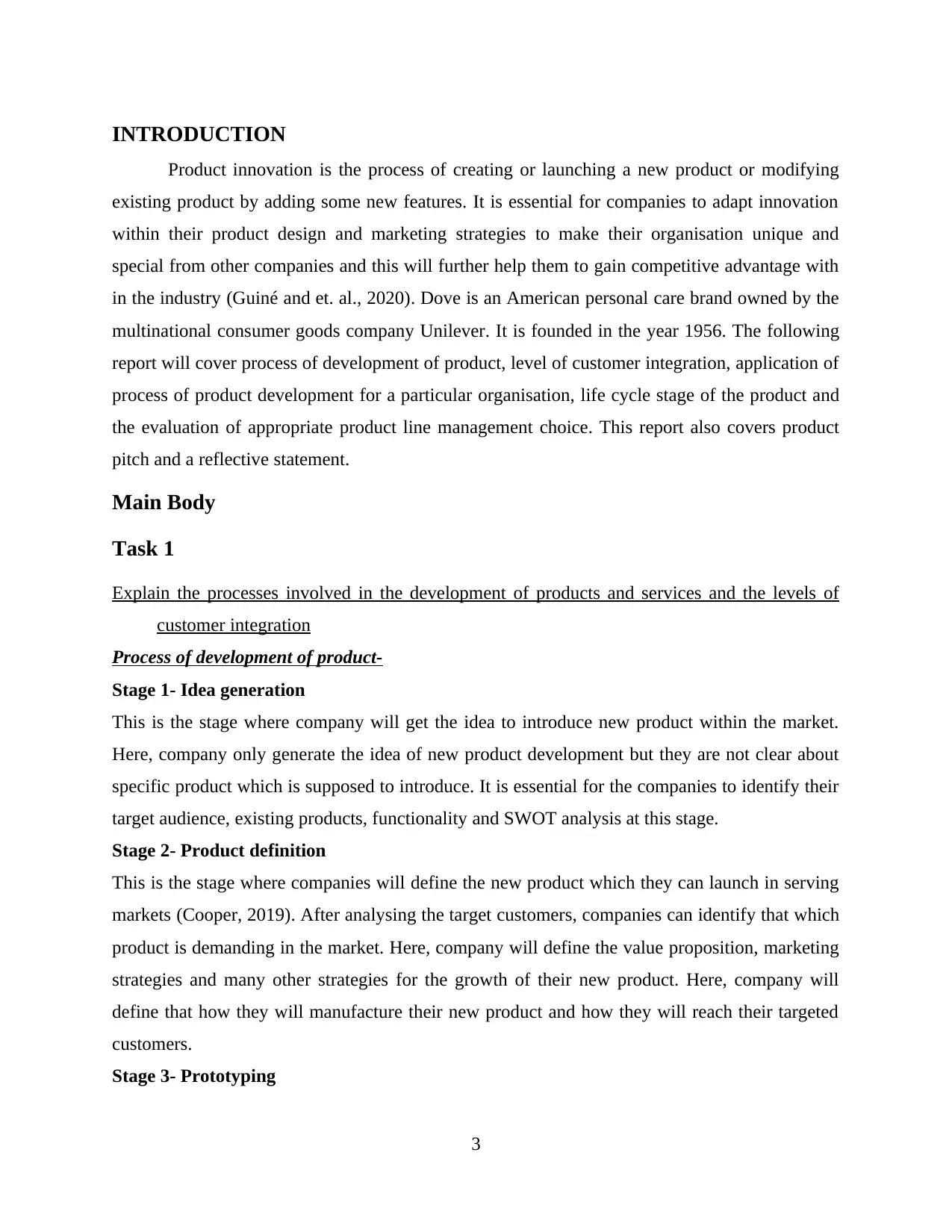
INTRODUCTION
Product innovation is the process of creating or launching a new product or modifying
existing product by adding some new features. It is essential for companies to adapt innovation
within their product design and marketing strategies to make their organisation unique and
special from other companies and this will further help them to gain competitive advantage with
in the industry (Guiné and et. al., 2020). Dove is an American personal care brand owned by the
multinational consumer goods company Unilever. It is founded in the year 1956. The following
report will cover process of development of product, level of customer integration, application of
process of product development for a particular organisation, life cycle stage of the product and
the evaluation of appropriate product line management choice. This report also covers product
pitch and a reflective statement.
Main Body
Task 1
Explain the processes involved in the development of products and services and the levels of
customer integration
Process of development of product-
Stage 1- Idea generation
This is the stage where company will get the idea to introduce new product within the market.
Here, company only generate the idea of new product development but they are not clear about
specific product which is supposed to introduce. It is essential for the companies to identify their
target audience, existing products, functionality and SWOT analysis at this stage.
Stage 2- Product definition
This is the stage where companies will define the new product which they can launch in serving
markets (Cooper, 2019). After analysing the target customers, companies can identify that which
product is demanding in the market. Here, company will define the value proposition, marketing
strategies and many other strategies for the growth of their new product. Here, company will
define that how they will manufacture their new product and how they will reach their targeted
customers.
Stage 3- Prototyping
3
Product innovation is the process of creating or launching a new product or modifying
existing product by adding some new features. It is essential for companies to adapt innovation
within their product design and marketing strategies to make their organisation unique and
special from other companies and this will further help them to gain competitive advantage with
in the industry (Guiné and et. al., 2020). Dove is an American personal care brand owned by the
multinational consumer goods company Unilever. It is founded in the year 1956. The following
report will cover process of development of product, level of customer integration, application of
process of product development for a particular organisation, life cycle stage of the product and
the evaluation of appropriate product line management choice. This report also covers product
pitch and a reflective statement.
Main Body
Task 1
Explain the processes involved in the development of products and services and the levels of
customer integration
Process of development of product-
Stage 1- Idea generation
This is the stage where company will get the idea to introduce new product within the market.
Here, company only generate the idea of new product development but they are not clear about
specific product which is supposed to introduce. It is essential for the companies to identify their
target audience, existing products, functionality and SWOT analysis at this stage.
Stage 2- Product definition
This is the stage where companies will define the new product which they can launch in serving
markets (Cooper, 2019). After analysing the target customers, companies can identify that which
product is demanding in the market. Here, company will define the value proposition, marketing
strategies and many other strategies for the growth of their new product. Here, company will
define that how they will manufacture their new product and how they will reach their targeted
customers.
Stage 3- Prototyping
3
⊘ This is a preview!⊘
Do you want full access?
Subscribe today to unlock all pages.

Trusted by 1+ million students worldwide

This is the stage where the company will prepare the documents related to business plan and
strategies and ways to achieve them. It consists of feasibility analysis, market risk analysis and
development strategies.
Stage 4- Initial design
This is the stage where the new design of product is made. Acceptance of all stakeholders are
essential and then they will decide that the idea of new product development will be continue or
not. Here, company will prepare a single sample of the new product and represent it inform of
the stakeholders of company so that they will analyse the benefits of introducing new product
within the market for their organisational growth.
Stage 5- Validation and testing
This is the stage which consist of testing the quality of new product (Product development
process: The 6 stages (with examples), 2022). It also consists of effectiveness of all stages from
product development to product marketing before the launch of new product.
Stage 6- Commercialization
This is the last stage of this process where company will launch their new product on their
website and stores and promote it well for increasing customer's awareness that the company has
launched a new product in the market. A good level of advertisements is required at this stage to
increase awareness to many customers as much as possible. It is essential to have good
communication between customers and company because here, customers can ask many
questions with company about their new product and they are required to respond as quick as
possible.
Customer integration refers to the relationship between customers and companies which
is built through the use of technology (Marion and Fixson, 2021). Today, most of the companies
make sure that they will build a good relationship with their customers to analyse their needs and
wants. Through the technology customers can directly contact to organisations and ask their
queries. Websites, social media channels, telephones, mobile phones and many others are the
examples used in customer integration. The main goals of customer integration are to improve
communication with customers, to gain customer retention and loyalty, to focus appropriately
upon targeted marketing’s and to learn how to tackle different kinds of customers.
4
strategies and ways to achieve them. It consists of feasibility analysis, market risk analysis and
development strategies.
Stage 4- Initial design
This is the stage where the new design of product is made. Acceptance of all stakeholders are
essential and then they will decide that the idea of new product development will be continue or
not. Here, company will prepare a single sample of the new product and represent it inform of
the stakeholders of company so that they will analyse the benefits of introducing new product
within the market for their organisational growth.
Stage 5- Validation and testing
This is the stage which consist of testing the quality of new product (Product development
process: The 6 stages (with examples), 2022). It also consists of effectiveness of all stages from
product development to product marketing before the launch of new product.
Stage 6- Commercialization
This is the last stage of this process where company will launch their new product on their
website and stores and promote it well for increasing customer's awareness that the company has
launched a new product in the market. A good level of advertisements is required at this stage to
increase awareness to many customers as much as possible. It is essential to have good
communication between customers and company because here, customers can ask many
questions with company about their new product and they are required to respond as quick as
possible.
Customer integration refers to the relationship between customers and companies which
is built through the use of technology (Marion and Fixson, 2021). Today, most of the companies
make sure that they will build a good relationship with their customers to analyse their needs and
wants. Through the technology customers can directly contact to organisations and ask their
queries. Websites, social media channels, telephones, mobile phones and many others are the
examples used in customer integration. The main goals of customer integration are to improve
communication with customers, to gain customer retention and loyalty, to focus appropriately
upon targeted marketing’s and to learn how to tackle different kinds of customers.
4
Paraphrase This Document
Need a fresh take? Get an instant paraphrase of this document with our AI Paraphraser
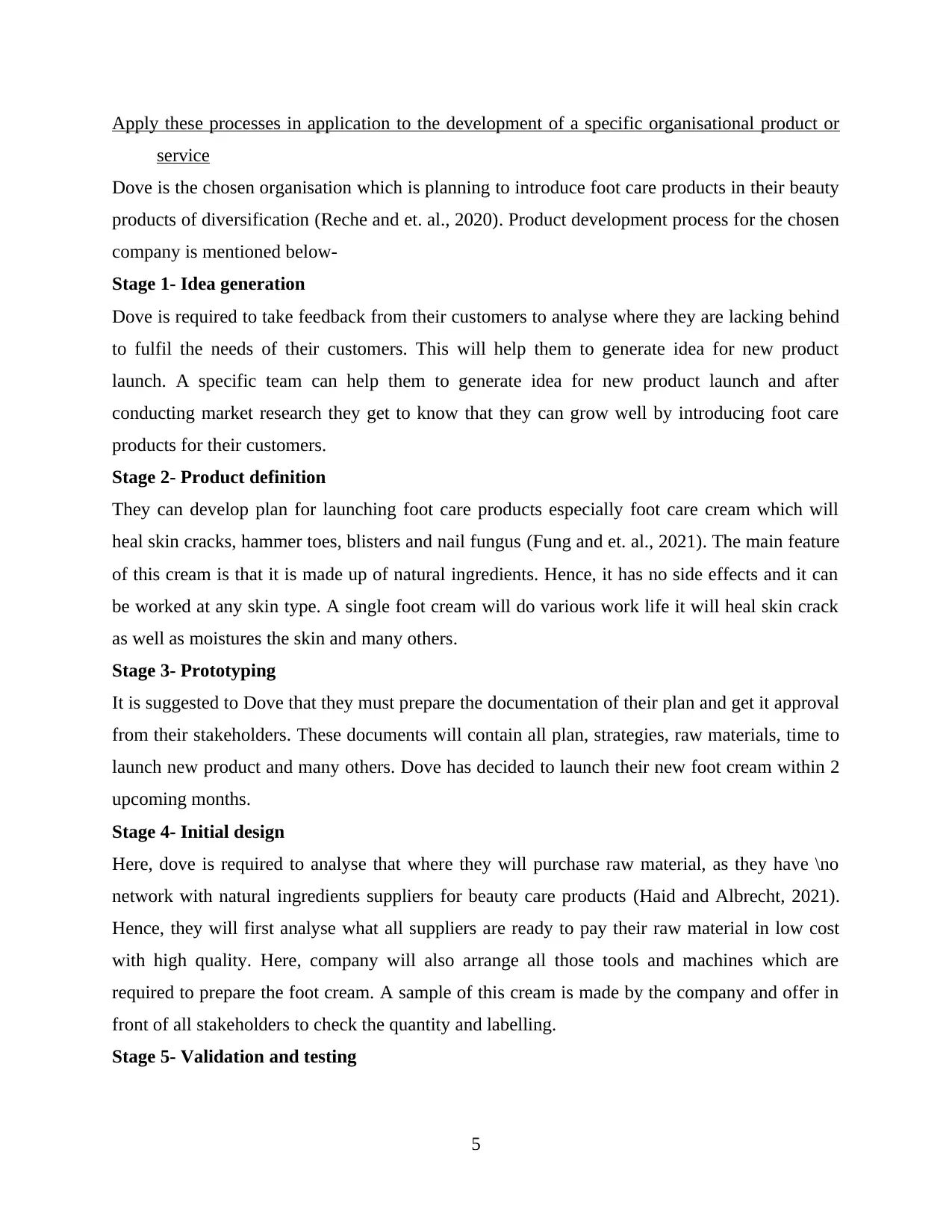
Apply these processes in application to the development of a specific organisational product or
service
Dove is the chosen organisation which is planning to introduce foot care products in their beauty
products of diversification (Reche and et. al., 2020). Product development process for the chosen
company is mentioned below-
Stage 1- Idea generation
Dove is required to take feedback from their customers to analyse where they are lacking behind
to fulfil the needs of their customers. This will help them to generate idea for new product
launch. A specific team can help them to generate idea for new product launch and after
conducting market research they get to know that they can grow well by introducing foot care
products for their customers.
Stage 2- Product definition
They can develop plan for launching foot care products especially foot care cream which will
heal skin cracks, hammer toes, blisters and nail fungus (Fung and et. al., 2021). The main feature
of this cream is that it is made up of natural ingredients. Hence, it has no side effects and it can
be worked at any skin type. A single foot cream will do various work life it will heal skin crack
as well as moistures the skin and many others.
Stage 3- Prototyping
It is suggested to Dove that they must prepare the documentation of their plan and get it approval
from their stakeholders. These documents will contain all plan, strategies, raw materials, time to
launch new product and many others. Dove has decided to launch their new foot cream within 2
upcoming months.
Stage 4- Initial design
Here, dove is required to analyse that where they will purchase raw material, as they have \no
network with natural ingredients suppliers for beauty care products (Haid and Albrecht, 2021).
Hence, they will first analyse what all suppliers are ready to pay their raw material in low cost
with high quality. Here, company will also arrange all those tools and machines which are
required to prepare the foot cream. A sample of this cream is made by the company and offer in
front of all stakeholders to check the quantity and labelling.
Stage 5- Validation and testing
5
service
Dove is the chosen organisation which is planning to introduce foot care products in their beauty
products of diversification (Reche and et. al., 2020). Product development process for the chosen
company is mentioned below-
Stage 1- Idea generation
Dove is required to take feedback from their customers to analyse where they are lacking behind
to fulfil the needs of their customers. This will help them to generate idea for new product
launch. A specific team can help them to generate idea for new product launch and after
conducting market research they get to know that they can grow well by introducing foot care
products for their customers.
Stage 2- Product definition
They can develop plan for launching foot care products especially foot care cream which will
heal skin cracks, hammer toes, blisters and nail fungus (Fung and et. al., 2021). The main feature
of this cream is that it is made up of natural ingredients. Hence, it has no side effects and it can
be worked at any skin type. A single foot cream will do various work life it will heal skin crack
as well as moistures the skin and many others.
Stage 3- Prototyping
It is suggested to Dove that they must prepare the documentation of their plan and get it approval
from their stakeholders. These documents will contain all plan, strategies, raw materials, time to
launch new product and many others. Dove has decided to launch their new foot cream within 2
upcoming months.
Stage 4- Initial design
Here, dove is required to analyse that where they will purchase raw material, as they have \no
network with natural ingredients suppliers for beauty care products (Haid and Albrecht, 2021).
Hence, they will first analyse what all suppliers are ready to pay their raw material in low cost
with high quality. Here, company will also arrange all those tools and machines which are
required to prepare the foot cream. A sample of this cream is made by the company and offer in
front of all stakeholders to check the quantity and labelling.
Stage 5- Validation and testing
5
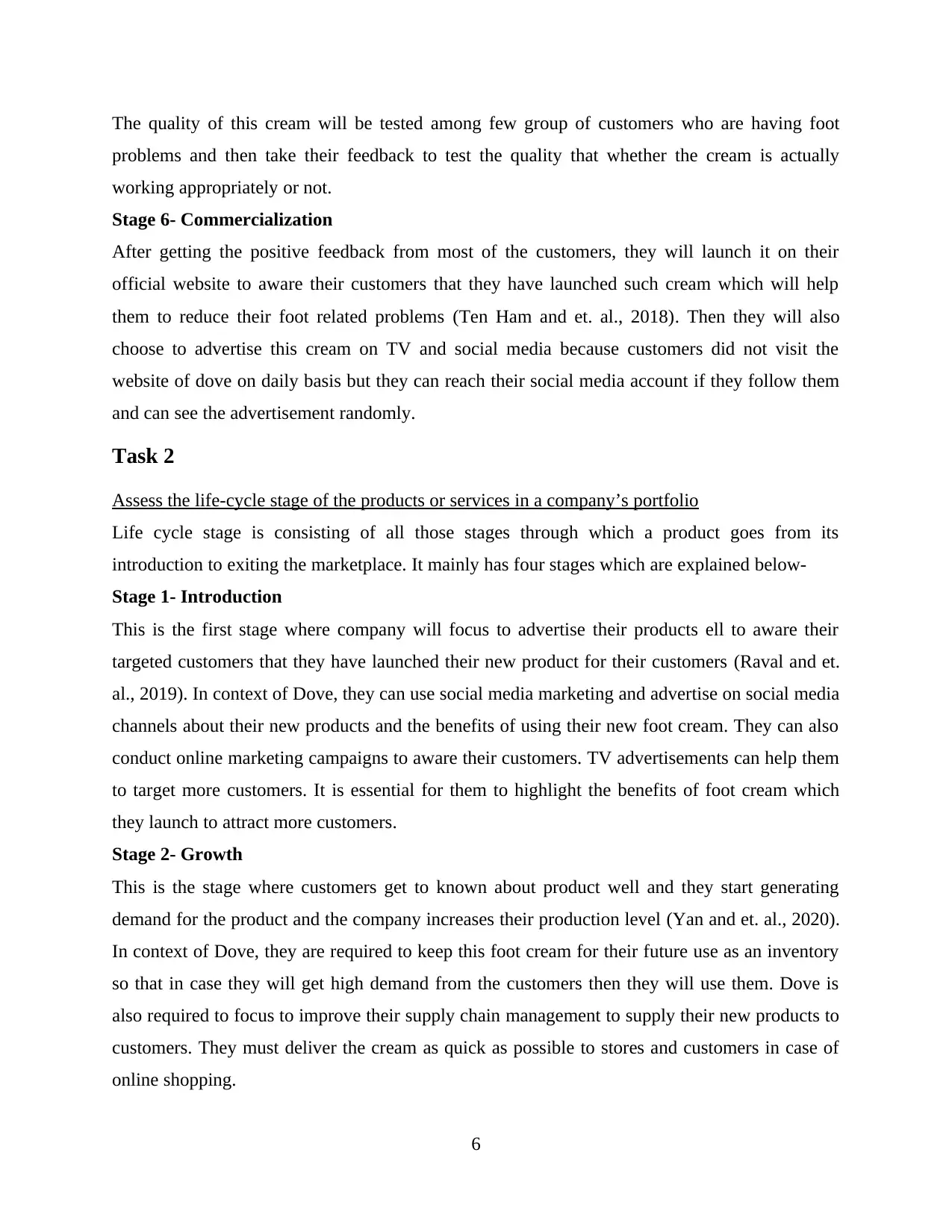
The quality of this cream will be tested among few group of customers who are having foot
problems and then take their feedback to test the quality that whether the cream is actually
working appropriately or not.
Stage 6- Commercialization
After getting the positive feedback from most of the customers, they will launch it on their
official website to aware their customers that they have launched such cream which will help
them to reduce their foot related problems (Ten Ham and et. al., 2018). Then they will also
choose to advertise this cream on TV and social media because customers did not visit the
website of dove on daily basis but they can reach their social media account if they follow them
and can see the advertisement randomly.
Task 2
Assess the life-cycle stage of the products or services in a company’s portfolio
Life cycle stage is consisting of all those stages through which a product goes from its
introduction to exiting the marketplace. It mainly has four stages which are explained below-
Stage 1- Introduction
This is the first stage where company will focus to advertise their products ell to aware their
targeted customers that they have launched their new product for their customers (Raval and et.
al., 2019). In context of Dove, they can use social media marketing and advertise on social media
channels about their new products and the benefits of using their new foot cream. They can also
conduct online marketing campaigns to aware their customers. TV advertisements can help them
to target more customers. It is essential for them to highlight the benefits of foot cream which
they launch to attract more customers.
Stage 2- Growth
This is the stage where customers get to known about product well and they start generating
demand for the product and the company increases their production level (Yan and et. al., 2020).
In context of Dove, they are required to keep this foot cream for their future use as an inventory
so that in case they will get high demand from the customers then they will use them. Dove is
also required to focus to improve their supply chain management to supply their new products to
customers. They must deliver the cream as quick as possible to stores and customers in case of
online shopping.
6
problems and then take their feedback to test the quality that whether the cream is actually
working appropriately or not.
Stage 6- Commercialization
After getting the positive feedback from most of the customers, they will launch it on their
official website to aware their customers that they have launched such cream which will help
them to reduce their foot related problems (Ten Ham and et. al., 2018). Then they will also
choose to advertise this cream on TV and social media because customers did not visit the
website of dove on daily basis but they can reach their social media account if they follow them
and can see the advertisement randomly.
Task 2
Assess the life-cycle stage of the products or services in a company’s portfolio
Life cycle stage is consisting of all those stages through which a product goes from its
introduction to exiting the marketplace. It mainly has four stages which are explained below-
Stage 1- Introduction
This is the first stage where company will focus to advertise their products ell to aware their
targeted customers that they have launched their new product for their customers (Raval and et.
al., 2019). In context of Dove, they can use social media marketing and advertise on social media
channels about their new products and the benefits of using their new foot cream. They can also
conduct online marketing campaigns to aware their customers. TV advertisements can help them
to target more customers. It is essential for them to highlight the benefits of foot cream which
they launch to attract more customers.
Stage 2- Growth
This is the stage where customers get to known about product well and they start generating
demand for the product and the company increases their production level (Yan and et. al., 2020).
In context of Dove, they are required to keep this foot cream for their future use as an inventory
so that in case they will get high demand from the customers then they will use them. Dove is
also required to focus to improve their supply chain management to supply their new products to
customers. They must deliver the cream as quick as possible to stores and customers in case of
online shopping.
6
⊘ This is a preview!⊘
Do you want full access?
Subscribe today to unlock all pages.

Trusted by 1+ million students worldwide
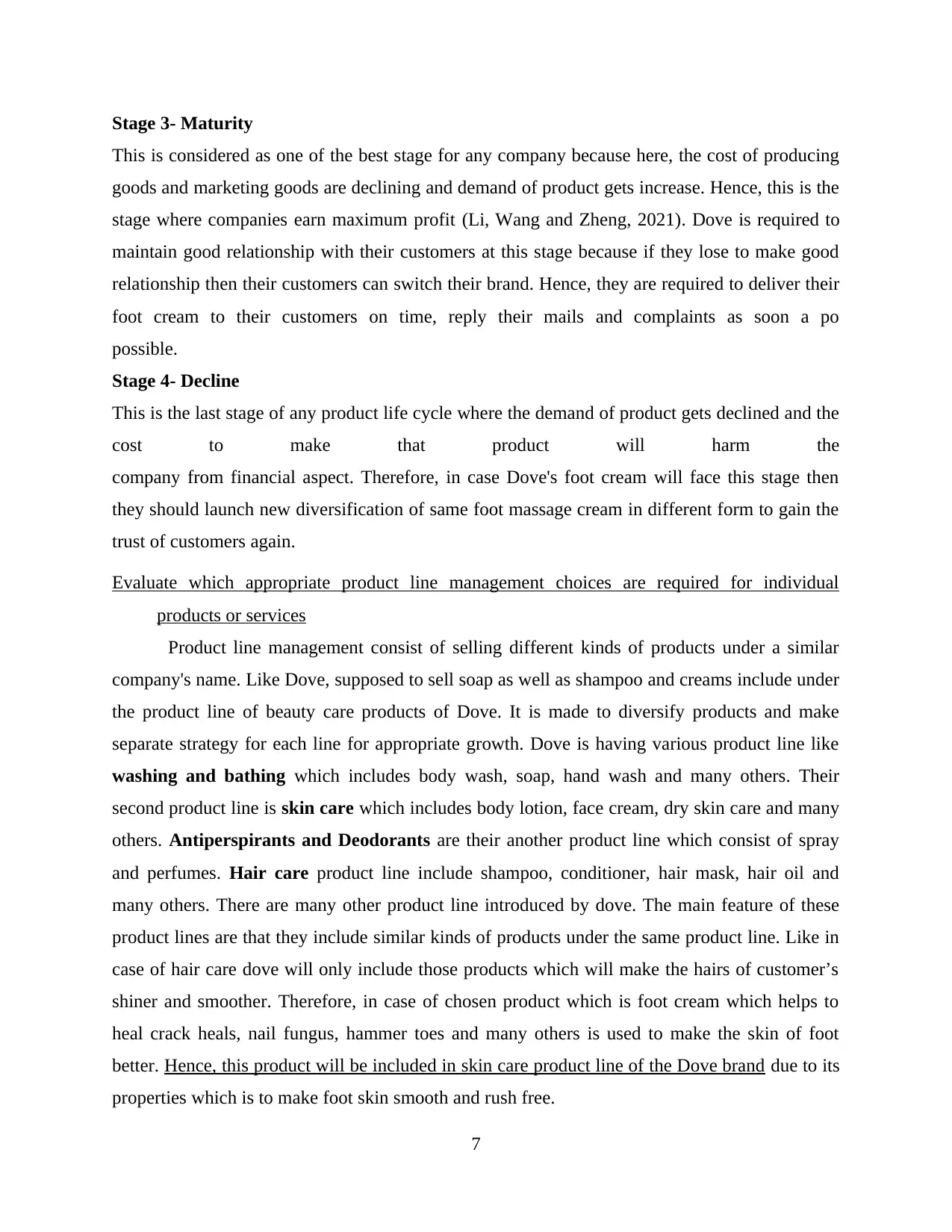
Stage 3- Maturity
This is considered as one of the best stage for any company because here, the cost of producing
goods and marketing goods are declining and demand of product gets increase. Hence, this is the
stage where companies earn maximum profit (Li, Wang and Zheng, 2021). Dove is required to
maintain good relationship with their customers at this stage because if they lose to make good
relationship then their customers can switch their brand. Hence, they are required to deliver their
foot cream to their customers on time, reply their mails and complaints as soon a po
possible.
Stage 4- Decline
This is the last stage of any product life cycle where the demand of product gets declined and the
cost to make that product will harm the
company from financial aspect. Therefore, in case Dove's foot cream will face this stage then
they should launch new diversification of same foot massage cream in different form to gain the
trust of customers again.
Evaluate which appropriate product line management choices are required for individual
products or services
Product line management consist of selling different kinds of products under a similar
company's name. Like Dove, supposed to sell soap as well as shampoo and creams include under
the product line of beauty care products of Dove. It is made to diversify products and make
separate strategy for each line for appropriate growth. Dove is having various product line like
washing and bathing which includes body wash, soap, hand wash and many others. Their
second product line is skin care which includes body lotion, face cream, dry skin care and many
others. Antiperspirants and Deodorants are their another product line which consist of spray
and perfumes. Hair care product line include shampoo, conditioner, hair mask, hair oil and
many others. There are many other product line introduced by dove. The main feature of these
product lines are that they include similar kinds of products under the same product line. Like in
case of hair care dove will only include those products which will make the hairs of customer’s
shiner and smoother. Therefore, in case of chosen product which is foot cream which helps to
heal crack heals, nail fungus, hammer toes and many others is used to make the skin of foot
better. Hence, this product will be included in skin care product line of the Dove brand due to its
properties which is to make foot skin smooth and rush free.
7
This is considered as one of the best stage for any company because here, the cost of producing
goods and marketing goods are declining and demand of product gets increase. Hence, this is the
stage where companies earn maximum profit (Li, Wang and Zheng, 2021). Dove is required to
maintain good relationship with their customers at this stage because if they lose to make good
relationship then their customers can switch their brand. Hence, they are required to deliver their
foot cream to their customers on time, reply their mails and complaints as soon a po
possible.
Stage 4- Decline
This is the last stage of any product life cycle where the demand of product gets declined and the
cost to make that product will harm the
company from financial aspect. Therefore, in case Dove's foot cream will face this stage then
they should launch new diversification of same foot massage cream in different form to gain the
trust of customers again.
Evaluate which appropriate product line management choices are required for individual
products or services
Product line management consist of selling different kinds of products under a similar
company's name. Like Dove, supposed to sell soap as well as shampoo and creams include under
the product line of beauty care products of Dove. It is made to diversify products and make
separate strategy for each line for appropriate growth. Dove is having various product line like
washing and bathing which includes body wash, soap, hand wash and many others. Their
second product line is skin care which includes body lotion, face cream, dry skin care and many
others. Antiperspirants and Deodorants are their another product line which consist of spray
and perfumes. Hair care product line include shampoo, conditioner, hair mask, hair oil and
many others. There are many other product line introduced by dove. The main feature of these
product lines are that they include similar kinds of products under the same product line. Like in
case of hair care dove will only include those products which will make the hairs of customer’s
shiner and smoother. Therefore, in case of chosen product which is foot cream which helps to
heal crack heals, nail fungus, hammer toes and many others is used to make the skin of foot
better. Hence, this product will be included in skin care product line of the Dove brand due to its
properties which is to make foot skin smooth and rush free.
7
Paraphrase This Document
Need a fresh take? Get an instant paraphrase of this document with our AI Paraphraser
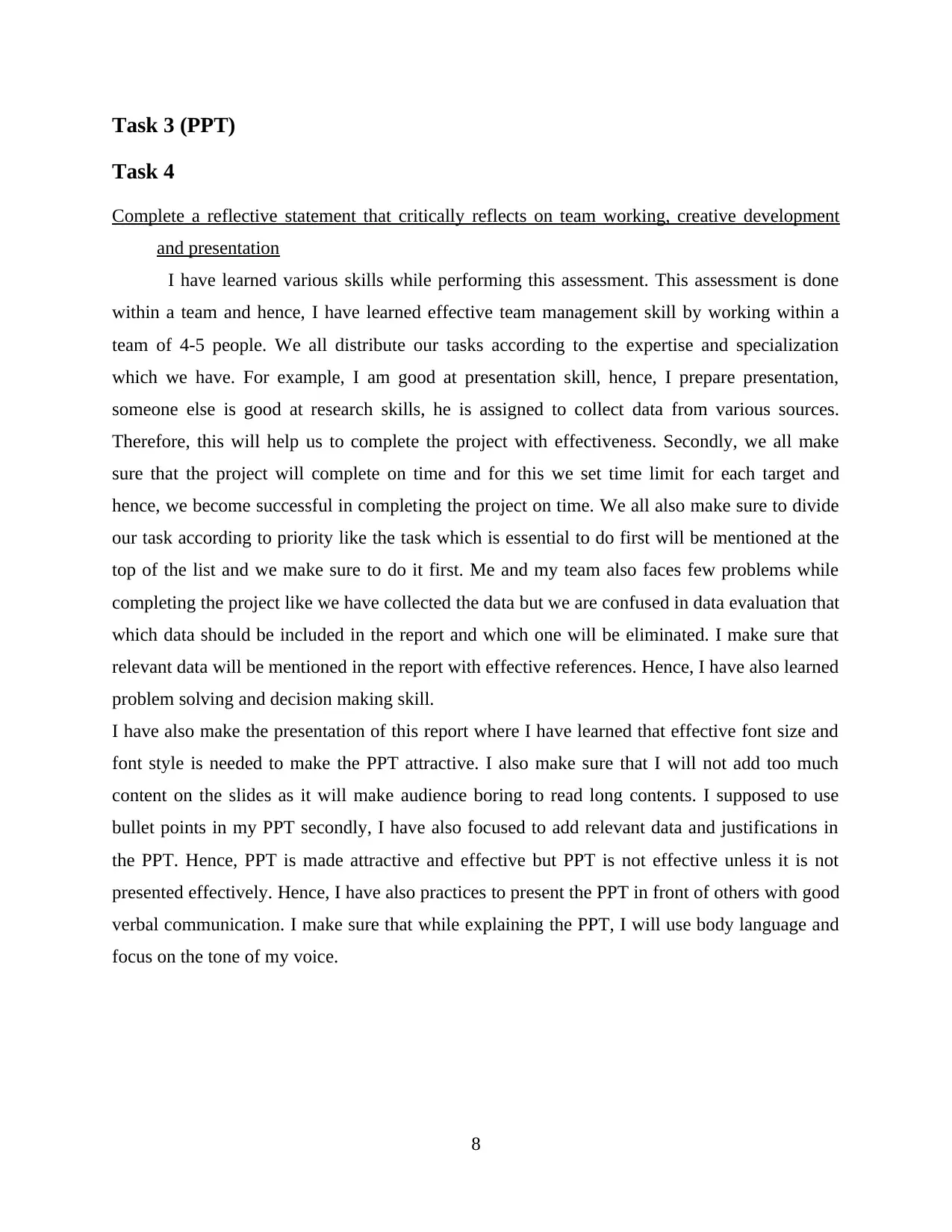
Task 3 (PPT)
Task 4
Complete a reflective statement that critically reflects on team working, creative development
and presentation
I have learned various skills while performing this assessment. This assessment is done
within a team and hence, I have learned effective team management skill by working within a
team of 4-5 people. We all distribute our tasks according to the expertise and specialization
which we have. For example, I am good at presentation skill, hence, I prepare presentation,
someone else is good at research skills, he is assigned to collect data from various sources.
Therefore, this will help us to complete the project with effectiveness. Secondly, we all make
sure that the project will complete on time and for this we set time limit for each target and
hence, we become successful in completing the project on time. We all also make sure to divide
our task according to priority like the task which is essential to do first will be mentioned at the
top of the list and we make sure to do it first. Me and my team also faces few problems while
completing the project like we have collected the data but we are confused in data evaluation that
which data should be included in the report and which one will be eliminated. I make sure that
relevant data will be mentioned in the report with effective references. Hence, I have also learned
problem solving and decision making skill.
I have also make the presentation of this report where I have learned that effective font size and
font style is needed to make the PPT attractive. I also make sure that I will not add too much
content on the slides as it will make audience boring to read long contents. I supposed to use
bullet points in my PPT secondly, I have also focused to add relevant data and justifications in
the PPT. Hence, PPT is made attractive and effective but PPT is not effective unless it is not
presented effectively. Hence, I have also practices to present the PPT in front of others with good
verbal communication. I make sure that while explaining the PPT, I will use body language and
focus on the tone of my voice.
8
Task 4
Complete a reflective statement that critically reflects on team working, creative development
and presentation
I have learned various skills while performing this assessment. This assessment is done
within a team and hence, I have learned effective team management skill by working within a
team of 4-5 people. We all distribute our tasks according to the expertise and specialization
which we have. For example, I am good at presentation skill, hence, I prepare presentation,
someone else is good at research skills, he is assigned to collect data from various sources.
Therefore, this will help us to complete the project with effectiveness. Secondly, we all make
sure that the project will complete on time and for this we set time limit for each target and
hence, we become successful in completing the project on time. We all also make sure to divide
our task according to priority like the task which is essential to do first will be mentioned at the
top of the list and we make sure to do it first. Me and my team also faces few problems while
completing the project like we have collected the data but we are confused in data evaluation that
which data should be included in the report and which one will be eliminated. I make sure that
relevant data will be mentioned in the report with effective references. Hence, I have also learned
problem solving and decision making skill.
I have also make the presentation of this report where I have learned that effective font size and
font style is needed to make the PPT attractive. I also make sure that I will not add too much
content on the slides as it will make audience boring to read long contents. I supposed to use
bullet points in my PPT secondly, I have also focused to add relevant data and justifications in
the PPT. Hence, PPT is made attractive and effective but PPT is not effective unless it is not
presented effectively. Hence, I have also practices to present the PPT in front of others with good
verbal communication. I make sure that while explaining the PPT, I will use body language and
focus on the tone of my voice.
8
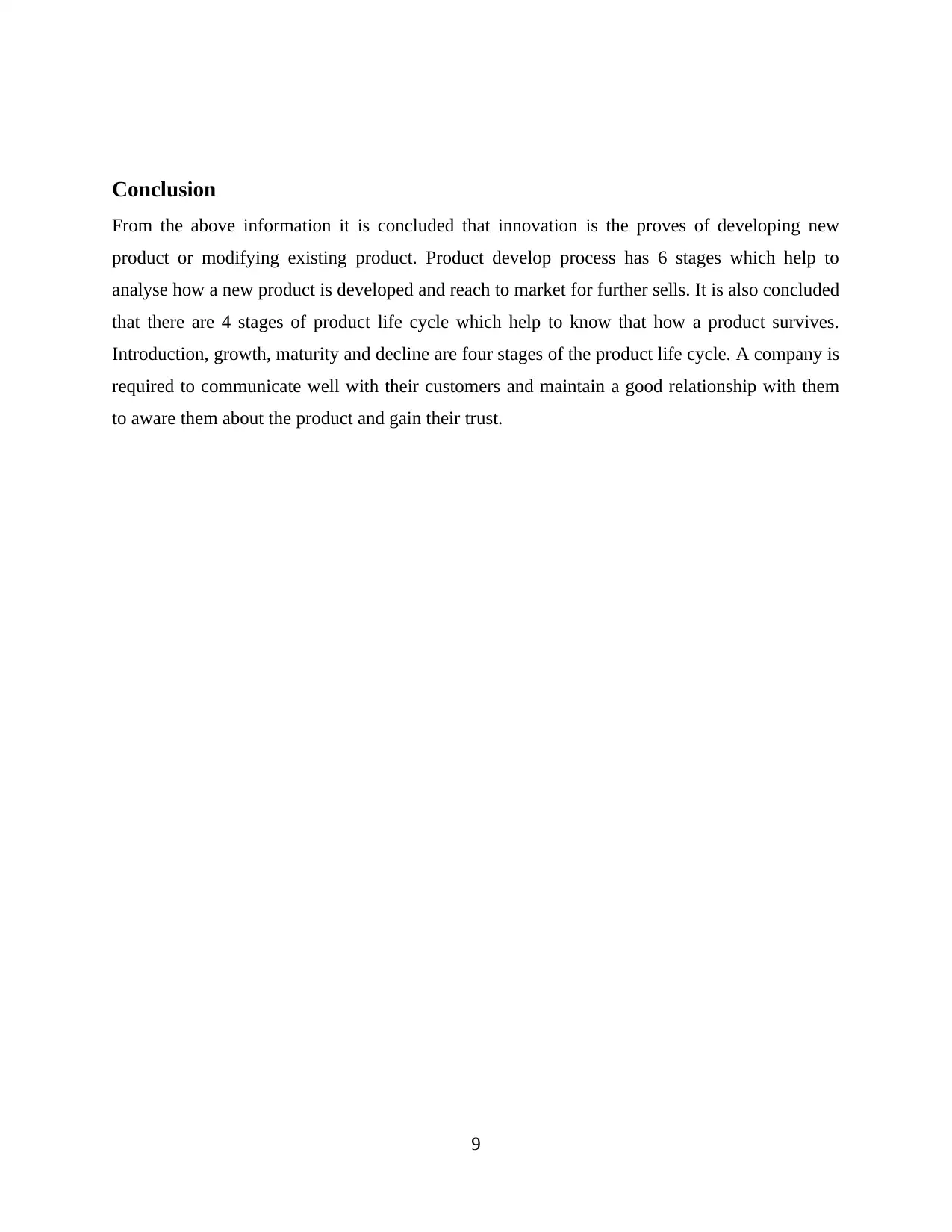
Conclusion
From the above information it is concluded that innovation is the proves of developing new
product or modifying existing product. Product develop process has 6 stages which help to
analyse how a new product is developed and reach to market for further sells. It is also concluded
that there are 4 stages of product life cycle which help to know that how a product survives.
Introduction, growth, maturity and decline are four stages of the product life cycle. A company is
required to communicate well with their customers and maintain a good relationship with them
to aware them about the product and gain their trust.
9
From the above information it is concluded that innovation is the proves of developing new
product or modifying existing product. Product develop process has 6 stages which help to
analyse how a new product is developed and reach to market for further sells. It is also concluded
that there are 4 stages of product life cycle which help to know that how a product survives.
Introduction, growth, maturity and decline are four stages of the product life cycle. A company is
required to communicate well with their customers and maintain a good relationship with them
to aware them about the product and gain their trust.
9
⊘ This is a preview!⊘
Do you want full access?
Subscribe today to unlock all pages.

Trusted by 1+ million students worldwide

REFERENCES
Books and Journals:
Cooper, R.G., 2019. The drivers of success in new-product development. Industrial Marketing
Management, 76, pp.36-47.
Fung, Y.N. and et. al., 2021. Sustainable product development processes in fashion: Supply
chains structures and classifications. International Journal of Production
Economics, 231, p.107911.
Guiné, R.P. and et. al., 2020. The link between the consumer and the innovations in food product
development. Foods, 9(9), p.1317.
Haid, M. and Albrecht, J.N., 2021. Sustainable tourism product development: An application of
product design concepts. Sustainability, 13(14), p.7957.
Li, B., Wang, H. and Zheng, W., 2021. Who will take on green product development in supply
chains? Manufacturer or retailer. Journal of Cleaner Production, 314, p.128000.
Marion, T.J. and Fixson, S.K., 2021. The transformation of the innovation process: How digital
tools are changing work, collaboration, and organizations in new product
development. Journal of Product Innovation Management, 38(1), pp.192-215.
Raval, N. and et. al., 2019. Importance of physicochemical characterization of nanoparticles in
pharmaceutical product development. In Basic fundamentals of drug delivery (pp. 369-
400). Academic Press.
Reche, A.Y.U. and et. al., 2020. Integrated product development process and green supply chain
management: Contributions, limitations and applications. Journal of Cleaner
Production, 249, p.119429.
Stock, G.N. and et. al., 2021. Coping with uncertainty: Knowledge sharing in new product
development projects. International Journal of Project Management, 39(1), pp.59-70.
Ten Ham, R.M. and et. al., 2018. Challenges in advanced therapy medicinal product
development: a survey among companies in Europe. Molecular Therapy-Methods &
Clinical Development, 11, pp.121-130.
Wijewardhana, G.E.H. and et. al., 2020. New product development process in apparel industry
using Industry 4.0 technologies. International Journal of Productivity and Performance
Management.
10
Books and Journals:
Cooper, R.G., 2019. The drivers of success in new-product development. Industrial Marketing
Management, 76, pp.36-47.
Fung, Y.N. and et. al., 2021. Sustainable product development processes in fashion: Supply
chains structures and classifications. International Journal of Production
Economics, 231, p.107911.
Guiné, R.P. and et. al., 2020. The link between the consumer and the innovations in food product
development. Foods, 9(9), p.1317.
Haid, M. and Albrecht, J.N., 2021. Sustainable tourism product development: An application of
product design concepts. Sustainability, 13(14), p.7957.
Li, B., Wang, H. and Zheng, W., 2021. Who will take on green product development in supply
chains? Manufacturer or retailer. Journal of Cleaner Production, 314, p.128000.
Marion, T.J. and Fixson, S.K., 2021. The transformation of the innovation process: How digital
tools are changing work, collaboration, and organizations in new product
development. Journal of Product Innovation Management, 38(1), pp.192-215.
Raval, N. and et. al., 2019. Importance of physicochemical characterization of nanoparticles in
pharmaceutical product development. In Basic fundamentals of drug delivery (pp. 369-
400). Academic Press.
Reche, A.Y.U. and et. al., 2020. Integrated product development process and green supply chain
management: Contributions, limitations and applications. Journal of Cleaner
Production, 249, p.119429.
Stock, G.N. and et. al., 2021. Coping with uncertainty: Knowledge sharing in new product
development projects. International Journal of Project Management, 39(1), pp.59-70.
Ten Ham, R.M. and et. al., 2018. Challenges in advanced therapy medicinal product
development: a survey among companies in Europe. Molecular Therapy-Methods &
Clinical Development, 11, pp.121-130.
Wijewardhana, G.E.H. and et. al., 2020. New product development process in apparel industry
using Industry 4.0 technologies. International Journal of Productivity and Performance
Management.
10
Paraphrase This Document
Need a fresh take? Get an instant paraphrase of this document with our AI Paraphraser
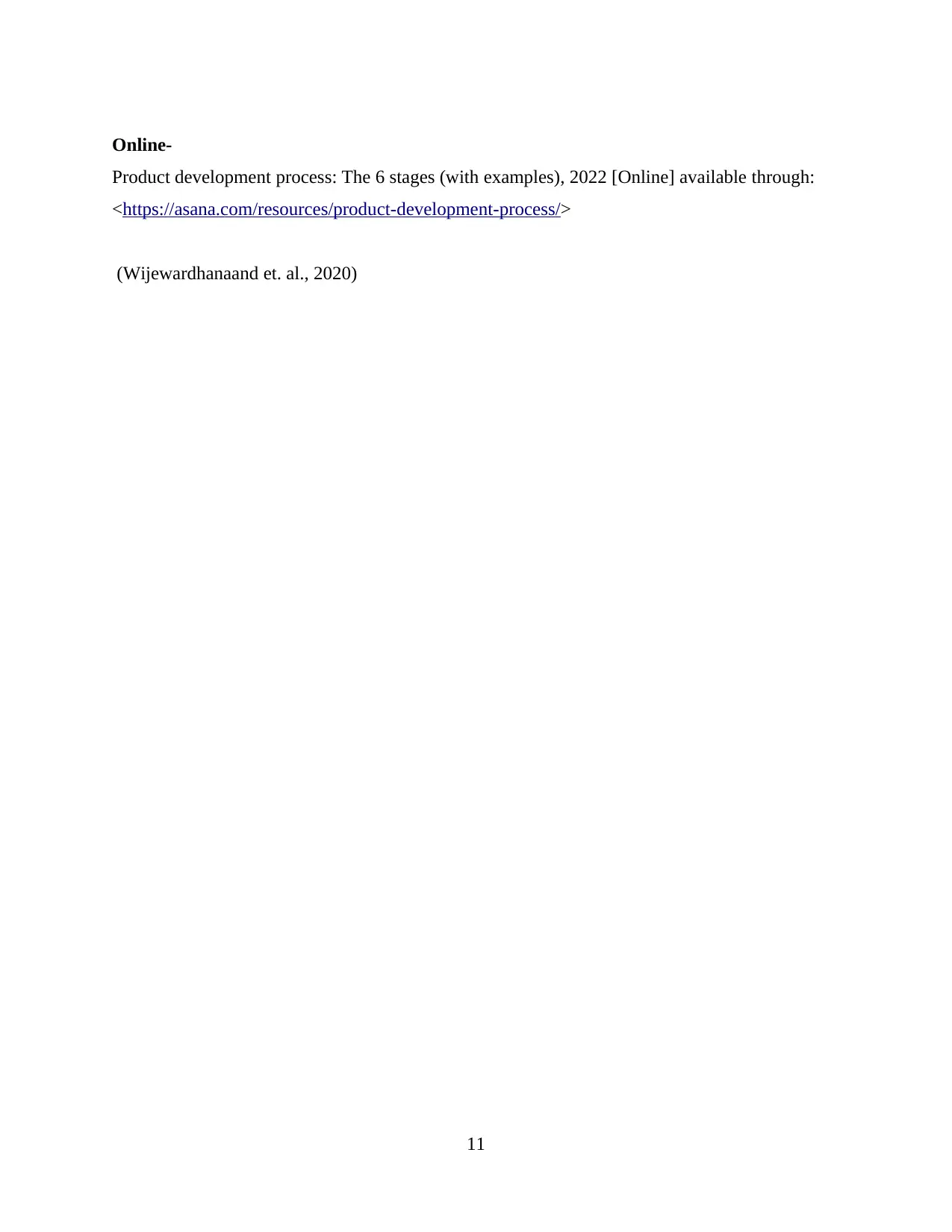
Online-
Product development process: The 6 stages (with examples), 2022 [Online] available through:
<https://asana.com/resources/product-development-process/>
(Wijewardhanaand et. al., 2020)
11
Product development process: The 6 stages (with examples), 2022 [Online] available through:
<https://asana.com/resources/product-development-process/>
(Wijewardhanaand et. al., 2020)
11
1 out of 11
Related Documents
Your All-in-One AI-Powered Toolkit for Academic Success.
+13062052269
info@desklib.com
Available 24*7 on WhatsApp / Email
![[object Object]](/_next/static/media/star-bottom.7253800d.svg)
Unlock your academic potential
Copyright © 2020–2025 A2Z Services. All Rights Reserved. Developed and managed by ZUCOL.




